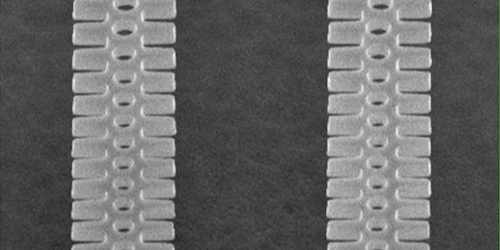Synchronizing Nanosized “Pendulums”
Hang two pendulum clocks from the same wall, and their pendulums will eventually tick in synchrony. Daniel Navarro-Urrios from the University of Barcelona and colleagues have now replicated this phenomenon—discovered more than 350 years ago—in photonic crystals that can become nanosized oscillators. The team says that a network of these nano-oscillators could act as a tunable system for studying problems related to collective dynamics of pendulum-like objects. The crystals could also be integrated into silicon chips and used for pattern recognition tasks in future computer technologies.
In their experiments, the team made two nearly identical photonic crystals. They connected the crystals via a thin wire, which provided a mechanical link between the oscillators (like the wall in the clock experiment). To set the crystals “swinging,” the team illuminated each with a laser. This action caused each crystal to produce oscillatory optical and mechanical signals analogous to the repeated ticks of a clock. The signals from the two initially unsynchronized crystals quickly synced up, with their “swings” moving in antiphase, meaning that the signal from one oscillator was the mirror image of the other.
While others have conducted similar experiments, Navarro-Urrios says that this demonstration is the first to “unambiguously” show synchronization. The demonstration is, in part, a fun trick, but it also has a serious side. Navarro-Urrios says that a long-term goal of his group’s work is to create large networks of these oscillators. Going from two crystals to a network of many should be, he says, “relatively straightforward.”
This research is published in Physical Review Letters.
–Katherine Wright
Katherine Wright is a Senior Editor of Physics.





